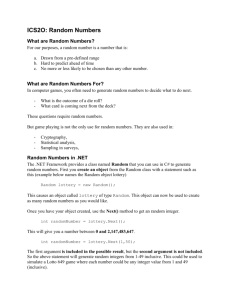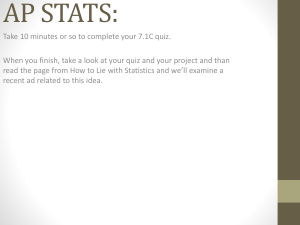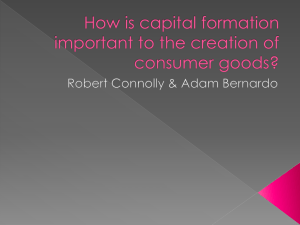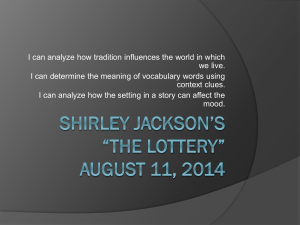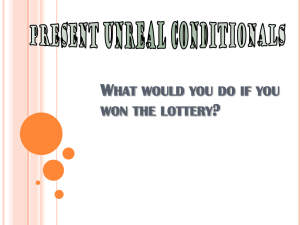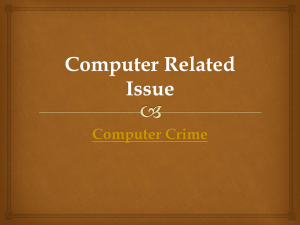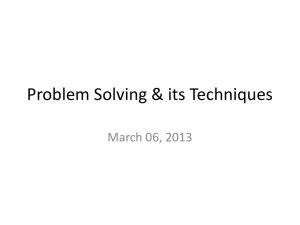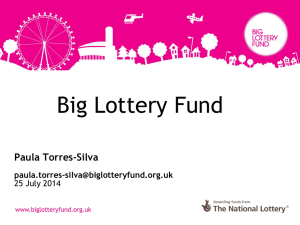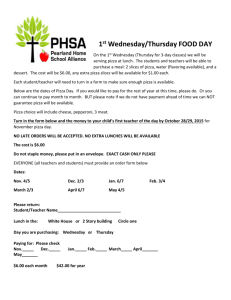Section 13.1 Problem 4. The reward matrix is computed to be: Noble
advertisement
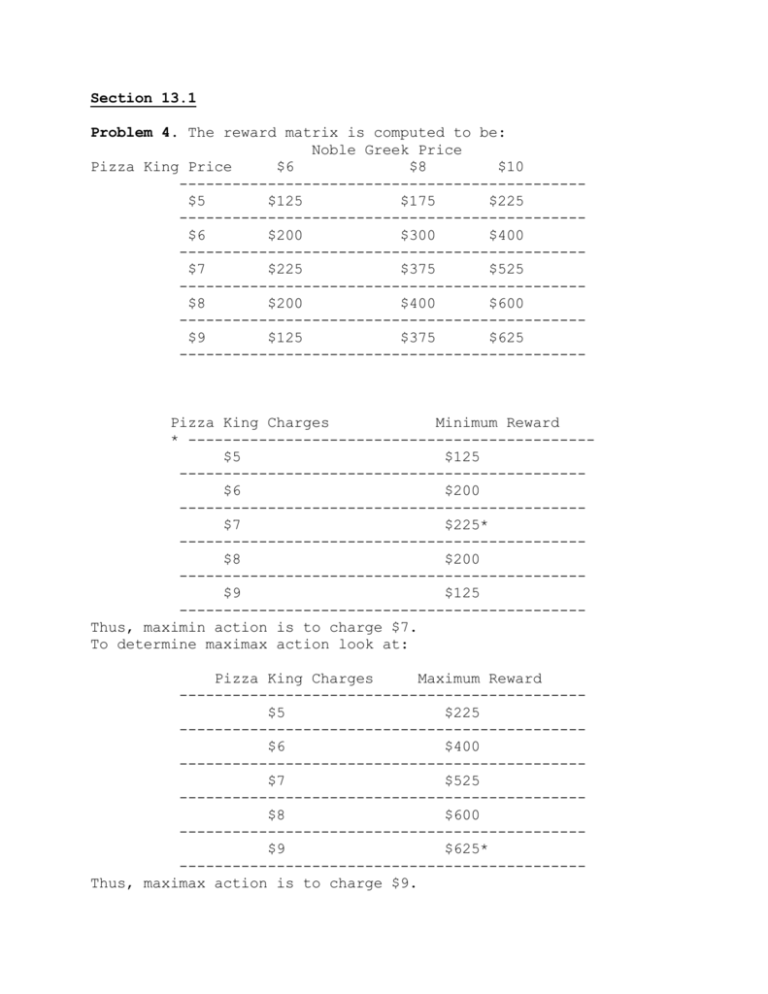
Section 13.1
Problem 4. The reward matrix is computed to be:
Noble Greek Price
Pizza King Price
$6
$8
$10
---------------------------------------------$5
$125
$175
$225
---------------------------------------------$6
$200
$300
$400
---------------------------------------------$7
$225
$375
$525
---------------------------------------------$8
$200
$400
$600
---------------------------------------------$9
$125
$375
$625
----------------------------------------------
Pizza King Charges
Minimum Reward
* ---------------------------------------------$5
$125
---------------------------------------------$6
$200
---------------------------------------------$7
$225*
---------------------------------------------$8
$200
---------------------------------------------$9
$125
---------------------------------------------Thus, maximin action is to charge $7.
To determine maximax action look at:
Pizza King Charges
Maximum Reward
---------------------------------------------$5
$225
---------------------------------------------$6
$400
---------------------------------------------$7
$525
---------------------------------------------$8
$600
---------------------------------------------$9
$625*
---------------------------------------------Thus, maximax action is to charge $9.
The regret matrix is
Pizza King Price
Noble Greek Price
---------------------------------------------$6
$8
$10
Maximum Regret
---------------------------------------------$5
$100
$225
$400
$400
---------------------------------------------$6
$25
$100
$225
$225
---------------------------------------------$7
$0
$25
$100
$100
---------------------------------------------$8
$25
$0
$25
$25*
---------------------------------------------$9
$100
$25
$0
$100
---------------------------------------------Thus, minimax regret action is to charge $8.
Expected reward for
for
for
for
for
$5
$6
$7
$8
$9
=
=
=
=
=
$175
$300
$375
$400
$375
Thus, Pizza King maximizes their expected reward by charging $8.
Section 13.2
Problem 3. Since u''(x) = 0, I am now risk neutral.
E(U for L1) = 2(19,000) + 1 = 38,001
E(U for L2) = 0.1(20,001) + 0.9(40,001) = 38,001
Thus, I am indifferent between L1 and L2. (This is because a risk
neutral decision maker chooses between lotteries on basis of
expected value and L1 and L2 have same expected value. Let
x = CE(L2). Then 2x + 1 = 38,001 or x = $19,000. Thus
RP for L2 = 19,000 - 19,000 = $0.
Problem 7. Let u(A) = 1 and u(D) = 0. Then u(C) = .25,u(B) = .70
and OR course has expected utility of
0.10(1) + 0.4(0.70) + 0.5(0.25) = 0.505
Statistics course has expected utility of
0.7(0.70) + 0.25(0.25) + 0.1(0) = 0.5525. Thus, Statistics course
should be taken.
Problem 10. Hiring CPA has expected utility of
0.2u(35,500) + 0.8u(31,500) =
0.2(35,500)1/2 + 0.8(31,500)1/2 = 179.7
while Not Hiring CPA has expected utility of
(32,000)1/2 = 178.9. Thus, the CPA should be hired.
Problem 16.
(a) Let b = buying price of lottery. Then I am indifferent between
1/2 10,000 + 1,025 - b
----1/2 10,000 – 199 - b
----and
1
10,000
-----Then 100 = 1/2(11,025 - b)1/2 + 1/2(9801 - b)1/2.
(b) Let s = minimum selling price. Then I am indifferent between
1/2 11,025
-----1/2 9,801 and
------1
10,000 + s or
-------(10,000 + s)1/2 = 1/2(11,025)1/2 + 1/2(9,801)1/2
= 1/2(105 + 99) = 102
or 10,000 + s = 10,404 and s = $404
(c) Now we are indifferent between
1/2 2,025
---1/2
801
____
and
1
1,000 + s
----Thus, (1,000 + s)1/2 = 1/2(2025)1/2 + 1/2(801)1/2
= 1/2{45 + 28.30}
Therefore, 1000 + s = 1,343.22 and s = $343.22. Thus, the selling
price of the lottery (and indeed, the buying price for the
lottery) depends on our current asset position.
(d) Let a = asset position, b = buying price of lottery and s =
selling price of lottery. Then I am indifferent between
1/2
-----
a - b + 1,025
1/2
a - b - 199
-----and
1
a
.
-----I am also indifferent between
1/2 a + 1,025
------1/2 a - 199
-------
and
1
a + s
------Thus we have that 1/2(1 - eb-a-1025) + 1/2(1-eb-a + 199) = 1 – e-a
or -1/2(eb-a[e-1025 + e199] = -e-a.
Thus, eb = 2/(e-1025 + e199) and for all asset positions
b = ln {2/(e-1025 + e199))
We also know that
1/2(1 – e-a-1025) + 1/2(1 - e199-a) = 1 – e-a-s.
Thus,
-e-a(e-1025 + e199)/2 = -e-a-s or
e-s = (e-1025 + e199)/2 and
s = ln {2/(e-1025 + e199)}.
Thus, both the buying and selling price for the lottery are
independent of current asset position and are equal!
Section 13.4
Problem 1. Hire geologist. If favorable report, we drill; if
unfavorable report, do not drill. Expected net profits = $180,000.
EVWSI = $190,000 EVWOI = $170,000. EVSI = $190,000 - $170,000 =
$20,000. Since EVSI is greater than the cost of geologist, we
should hire geologist.
Section 13.5
Problem 3. P(cold forecast) =0.9(0.4) + 0.2(0.6) = 0.48,
P(warm forcast) = 1 -0.48 = 0.52.
P(cold
P(warm
P(cold
P(warm
year|cold
year|cold
year|warm
year|warm
forecast) = 0.36/0.48 = 0.75,
forcast) = 0.12/0.48 = 0.25,
forecast) = (0.1)(0.4)/0.52 = 1/13,
forecast) = (0.8)(0.6)/0.52 = 12/13.
Thus, test should not be taken and either wheat or corn can be
planted.
EVWSI = 6620 + 600 = 7220
EVSI =7220 – 6800 = 420
EVWPI = 7400, EVWOI = 6800, and EVPI = 7400 – 6800 = 600.
